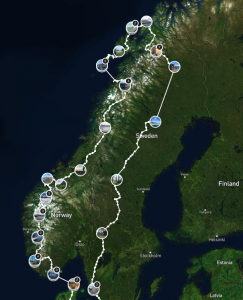 Our 3-month campervan trip in the summer of 2018 was planned around visiting Norway and in particular heading up to the Lofoten Islands.
Our 3-month campervan trip in the summer of 2018 was planned around visiting Norway and in particular heading up to the Lofoten Islands.
Norway is such a stunning country, so rich in natural beauty its difficult to define the highlights. Sometimes just rounding a bend will give another view to die for. Limitless wildcamping and plenty of service facilities make it campervan/MH heaven.
We arrived in Kristiansand via ferry from Hirtshals in northern Denmark before heading to the western fjords and then making our way north. I’ve detailed below some of our more memorable places (listed in order of our 3-week route up through Norway).
For our full route see our Polarsteps page here.
For more details and a Google maps list of all our overnight stops see here.
Priekestolen – Pulpit Rock
One of the Norway’s iconic spots, Preikestolen (aka Pulpit Rock) commands an imposing position 600 metres above the waters of Lysefjord. Overnight camping was forbidden in the main car-park so we back-tracked, taking the impressive bridge back over the fjord to find a spot by a secluded beach. Up early the next morning we parked by 0630 and set off for the two-hour hike up to Priekestolen. Early drizzle gave way to the occasional break in the clouds but as we neared the summit the mist closed in. The flat-topped rock was immediately recognised from a million photos but the famed view down the fjord was shrouded in grey mist. After waiting in vain for the mist to clear we descended just as the coaches and their hoardes were starting up the track.
Trolltunga
Trolltunga is a rock formation situated about 1,100 metres above sea level in the municipality of Odda in Hordaland county, Norway. The cliff juts horizontally out from the mountain, about 700 metres above the north side of the lake Ringedalsvatnet. With a 23km round-trip hike to get there from the main car-park we knew we needed an early start.
We’d hoped to be able to overnight in the car-park at Skjeggedal to start the Trolltunga hike but found that motorhomes/campervans are not allowed on the 6km mountain road up. So we camped in the lower car-park at Tyssehallen and rose at 5am to catch the first bus up at 0640.
The hike starts at Skjeggedal and for the first 4km follows a tarmac road up switchback after switchback (if you queue you can catch a shuttle to avoid this section). You then reach a plateau before another climb towards the first views of Ringedalsvatnet lake after around 7km. From here you can start to see the cliff edge some 700m above the lake from which Trolltunga protrudes. The path winds its way around until finally, after 3 hours 45 mins we reached Trolltunga after 14km.
At least we guessed we had reached Trolltunga – we saw only see large queue, which as a Brit we joined. We had to walk to the edge of the cliff to see Trolltunga in its full glory perched above the blue waters of Ringedalsvatnet. We’d originally planed to leave much earlier in the morning to miss the queues but having had to take the bus meant we joined a long queue. Many had even camped overnight to avoid the queues. Finally, almost 4 hours later, it was our turn for the obligatory photo opportunity – you need to make friends in the queue so someone can take photos of you – before the long return hike in the sun!
By 6pm we reached the top of the switchback road with still 4km of downhill to go. We were resigned to missing the 6.30pm bus – the later bus wouldn’t be till 8.30pm – but upped our speed to meet it as it arrived in the car-park. I quickly grabbed an ice-cold beer from a kiosk, only to find that is was alcohol-free – no matter, it was gorgeously refreshing!
Stats: 28km, 1,381 metres of total ascent, 38,400 steps, 7 hrs 41 mins of hiking, 4 hours of queuing! But it was worth it!
Oldevatnet & Briksdal Glacier
After a stunning drive over three mountain passes. Just when we didn’t think the views could get any better we entered the valley of Oldedalen. Azure blue waters bounded by steep snow-capped mountains, the valley lead up to the Briksdalsbreen glacier.
We stumbled on a small campsite (Oldevatn Camping) where a bridge crossed the lake and managed to grab the last waterside spot, spending lovely couple of days relaxing and fishing (and catching an England World Cup match on the campsite TV).
An early start saw us drive up to the head of the valley and the short hike up to the impressive Briksdal glacier. The campsite Melkevoll at the head of the valley is also recommended.
Dalsnibba, Trollstigen & Geiranger
Following Route 63 over a couple of twisty mountain passes we came across a private toll road up to Dalsnibba view point. After several hairy switch-backs we were above high above the cloud obscuring the fjords below. The viewing point gave a fantastic 360 degree panoramic vista over snow-pocked mountains but Geirangerfjord remained unfortunately obscured.
Trollstigen, is a part of the Norwegian Scenic Route; Geiranger – Trollstigen where the road twists through 11 hairpin bends as it descends from Stigrøra (858 metres above sea level) and where there’s a visitors centre and viewing platform. Despite the the low-cloud meaning visibility was almost zero, scores of visitors still trawled down to the viewing platform.
The long brake-testing descent gave us our first view Geirangerfjord, perhaps the most famed of the Norwegian fjords and a regular cruise-ship destination. We slipped through the small town, full of tourists being shipped on/off their ships. We found a small fjord-side picnic spot and settled in for a quiet evening before the tortuous ascent of Eagles Road in the morning.
Atlantic Road
The Atlantic Road is another of Norway official ‘Tourist Routes’ and runs from Bud – a charming little fishing village worth a visit – in the south to Kristiansund in the north, offering scenery, culture and history. A major engineering feat, opened in 1989, Atlanterhavsvegen is marketed a one of the worlds most beautiful drives (I wouldn’t go that far!), It’s the 9km stretch across the islands in the middle that attract the most attention, with its numerous causeways and bridges interlinking tiny islands with the mainland. We parked up overnight in one the many lay-bys to enjoy a beautiful sunset.
Innerdalen
Innerdalen is often regarded as one of Norway’s most beautiful valleys. Driving in from the west it’s easy to see why with soaring cliffs enclosing a wooded valley and a blue river cascading down. The mountains at the head of the valley are more pronounced and majestic then we’ve seen to date. Still replete with pockets of snow, the shapely 1452m Innerdalstårnet dominates the upper valley. We found a parking spot by the river before the end of the road and hiked up to the Renndølsetra and Innerdalshytta huts by the lake. The latter popular with locals who hike up for the buffet meals available.
Saltstraumen
Heading further north, Saltstraumen is the very definition of maelstrom. A huge fjord links to the sea by a 150m wide channel creating the strongest tidal current in the world. At its peak it reaches 25mph and creates the most amazing whirlpools and convulsions – the water becoming alive with a terrifying power. It’s also a famous fishing spot with a number of record breaking fish caught here.
Within a few minutes I’d hooked a fish but I made a rookie mistake while waiting for Ali to bring the landing net, allowing the fish to reach the rocks and weed where it burrowed itself and wriggled free. That was as close as I got to a catch before the current drove my lure into the weed by the shore where it stuck fast. Cutting free was my only escape though meaning my fishing was over.
Bodø
Memorable for the spectacular sunset as we waited for the Lofoten ferry in the morning. We found a spot by the waters edge, a few miles east of Bodø. Being above the Artic Circle, the sun never quite set, but cast a warm glow over the islands out to sea,
Lofoten Islands
Our trip highlight and main destinations, the Lofoten Islands had been on our bucket-list for some years. The ferry from Bodø not only cuts down the miles but adds to the awe as the jagged peaks of the Lofotens slowly come into view, rising out of the sea like a serpent. With an ethereal light and majestic jagged peaks rising from the sea it really does feel quite other-wordly. As we neared then islands the tiny fishing villages and archetypal red-huts came into view.
Alighting the ferry we were immediately fighting the crowds on narrow roads as the ferry funnels the new arrivals in the same direction. We headed, as most do, to A, a former fishing village turned tourist museum before heading back west. The interplay between the peaks and fjords were just stunning and we took every opportunity venture of the main road to seek out the quieter bays and trek a few peaks.
Kvalvika Beach/Ryten
Kvalvika beach is a hidden gem, accessible only by an hours walk. We overnighted by the gorgeous bay north of Fredvang for where we ascended for 2 hours up the headland peak of Ryten (967m), giving direct views down on the beach and beyond.
Haukland Beach and Himmeltinden
Haukland is one of Lofoten’s most famous beaches. The white sand and crystal blue waters make Haukland a popular summer destination among tourists, Our initial view of Haukland Beach matched the expectations with a large encircled with white sand, backed by imposing peaks. We managed to find a spot directly next to the beach, though if you continue through the tunnel there’s a convenient campsite on the neighbouring Uttakliev beach. Hiking up Himmeltinden afforded amazing views along the coast with its myriad of islands and islets.
If you want some inspiration on Lofoten Island beaches in the form of beautiful photography I can highly recommend the excellent 68North.com website.
Senja
Arriving by ferry from Andenes, Senja is often considered to be a miniature and quieter version of the Lofotens. Norway’s second largest island has the Lofoten’s sea, mountains, beaches with a quieter more authentic vibe. From the sweeping beach at Ersfjord, the shapely peak of Heston, the unique islet of Husøy, Senja feels like Norway at its most pure.
From Senja we headed south-east, crossing over to Sweden for the long drove south and onto mainland Europe for the remaining two-months of our trip.
Norway Hints & Tips
Getting there
With no direct ferries from the UK, getting there means either a ferry to Calais or Rotterdam and then a long slog up across Europe. This severely restricts your options for a short trip – a minimum of 3 weeks in needed and even then you’ll likely be be restricted to the Western Fjords. Driving in Norway is slow with mostly single carriageway roads, circuitous routes around fjords, plenty of short ferry hops and strict speed-limits. We took the ferry from Hirtshals in northern Denmark to Kristiansand which is probably the shortest route to Norway.
When to go
The summer months benefit from the settled weather and being above the Artic Circle means long days but is naturally busier. Spring and autumn are quieter – spring benefitting from snow-capped peaks, autumn bringing colours and a chance of seeing the Northern Lights. Remember the nights close in quickly and the temperature drops from November and in winter there are only a few hours of daylight, or none as you head further north.
Driving
Driving is safe and the roads are generally quiet but it’s easy to underestimate travel times. Most main roads are only single-carriageway and the twisty nature makes overtaking difficult, especially in a campervan. Ferries form a continuum of many roads particularly in the western fjords – you just arrive and wait for the next ferry. Ferry prices depend on your vehicle length and increase if you’re over 6m. Some of the roads and tunnels have tolls (automatic, camera-based) – we registered with https://www.epcplc.com/ though toll charges took several months to come through. Note that dipped headlights are required during daylight hours.
Money
Almost everywhere in Norway takes card – we took some cash and had to make an effort to use it before we left. I can recommend a Revolut card – no exchange fees, great rates, secure and super-easy to manage and top-up via an app. Check out Revolut here.
Wildcamping
Of the 11 countries we visited on our 3-month trip, Norway was the easiest for wildcamping and services. A large country with a small population, stunning scenery and plenty of service points means Norway is wildcamping heaven. Norway has relaxed laws for wild camping and after each turn you’ll find a new fjord, beach, forest or mountain pass to rock-up and relax. We used the Park4night app extensively, though it has resulted in certain places becoming campervan honeypots.
For our full route see our Polarsteps page here.
For more details and a Google maps list of all our overnight stops see here.
Food & Drink
There’s no getting away from the fact that Norway is expensive – groceries were at least double UK prices. We stocked up in Denmark before the ferry crossing, or if you are arriving from Sweden then stock up before you cross the border. There are limits on bringing alcohol into Norway though we weren’t checked when we arrived on the ferry.
Pets
Norway has similar entry rules to the UK for dogs, i.e. have to visit a vet to dispense a working tablet between 24 hours and 5 days prior to arrival. If you are planning on heading direct to Norway from the UK, then with a bit of planning you can have this done in the UK – we arrived in Kristiansand just within the 5 day window – though ironically we weren’t checked on entry.

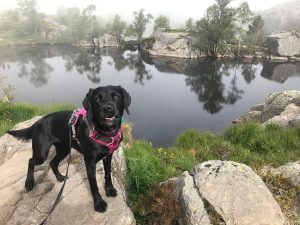
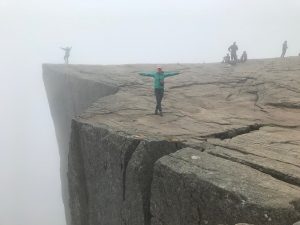
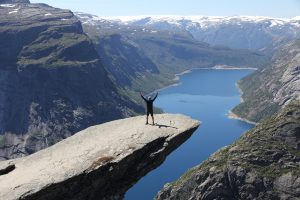
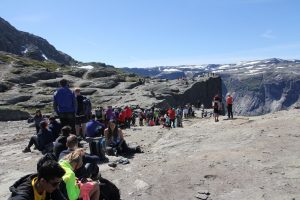
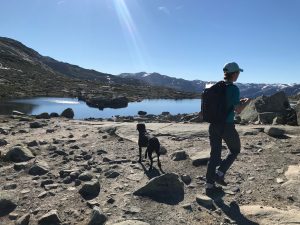
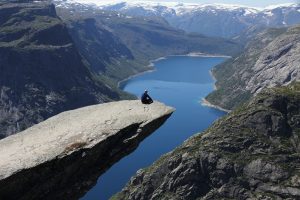
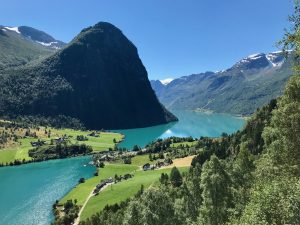
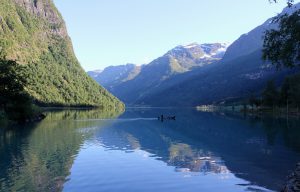
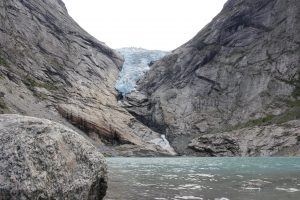
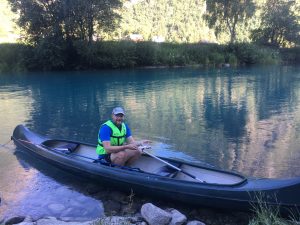
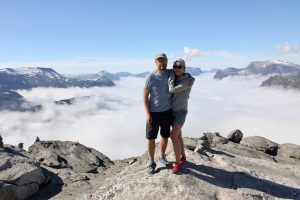
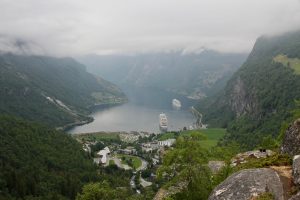
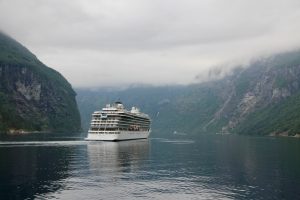
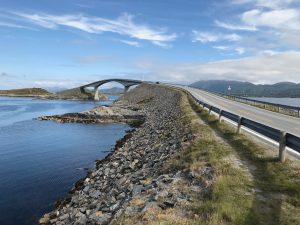
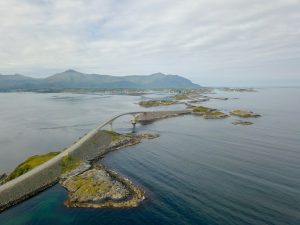
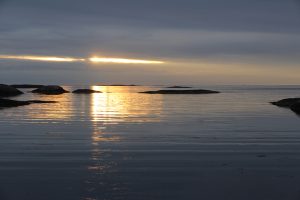

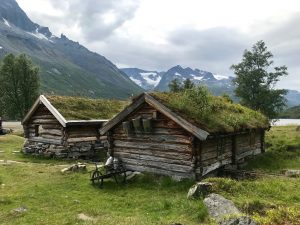
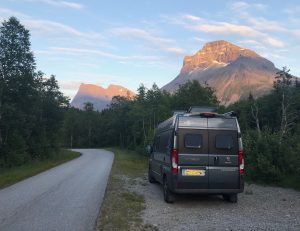
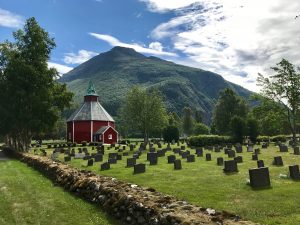
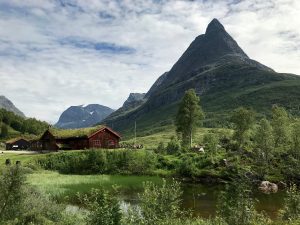
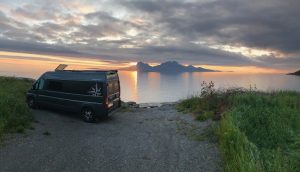
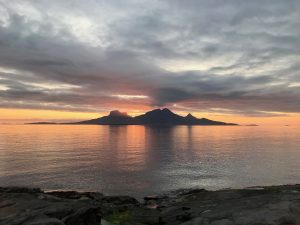
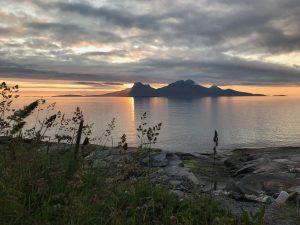
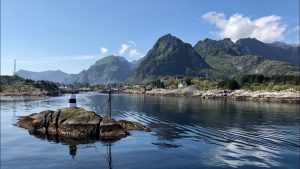
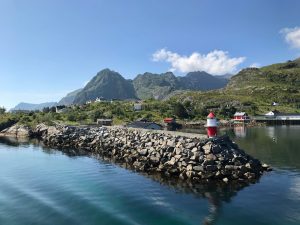

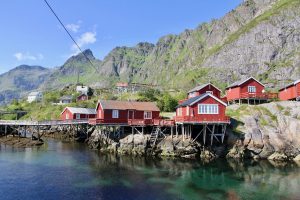
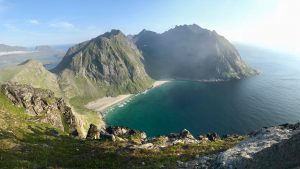
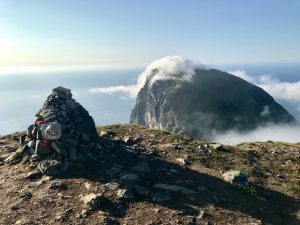
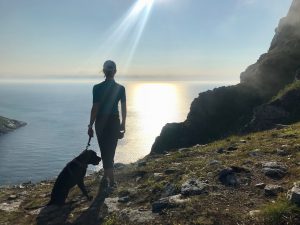
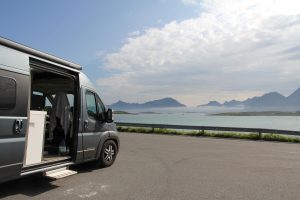
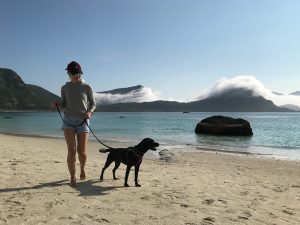
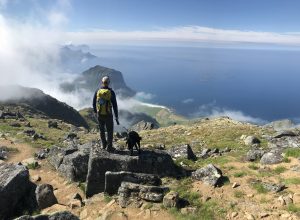
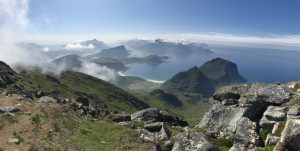

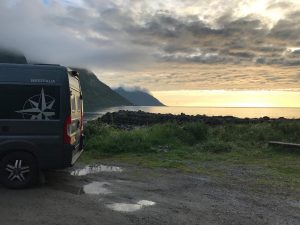
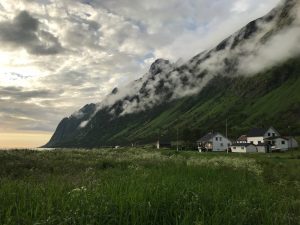
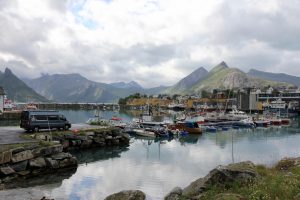
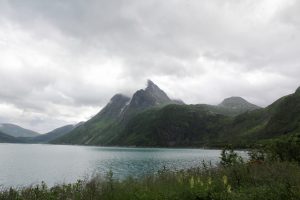
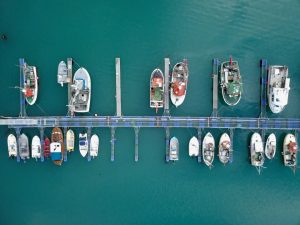
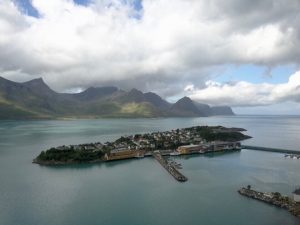
Lovely summary with done great tips! We hope to go next year.
Nina
Thanks Nina – you’ll love Norway!
Hi how many kms was your trip & is it suitable for children.
Hi Michael, we did 14,000km during our 3-month trip and packed a lot in!
http://www.amountainhigh.co.uk/2018/11/europe-camper-trip-overnight-stops/
If we had more time we would have loved to have taken our time and explored more. The Norwegians are very family orientated – always see families with children enjoying the outdoors.
Thanks – very enjoyable and interesting. Added to our bucket list.
Thanks for taking the time to do this. A really helpful guide. We are spending a few weeks in Norway and Finland in our campervan from around 28th May 2020 to end of June. It’s dawning on us as we read different blogs, info etc that this will not be long enough but it’s all we can do this time. We will be taking the ferry to Kristiansund and basically following the coast. I have a couple of questions, which if you’re able to reply to I would be very grateful.
We are looking to use park4night app. Am I right to think that erecting an awning is not practical or desirable or allowed?
Is it ok to just wind out a shade awning?
We also have a small awning that goes over the tailgate that we use to give us some protection from the elements for cooking and showering as we have no fitted facilities in our campervan, do you think this would be acceptable to put up?
Any advice welcomed. Thank you
Hi Lindy, the longer the better in Norway as the distances and the road (and scenery) make for slow travel, but it’s worth it!:) In general wild camping is tolerated in Norway but the use of awnings etc. would be frowned upon and ought to be reserved for campsites (same would be true anywhere). On our travels we didn’t see any other motorhomes/vans erecting any awnings (erect or wind-out) unless on a campsite. I think a shade around your tailgate may be more acceptable/practical. We did stop in some amazing remote spots where we were the only ones for miles so more likely you’d have no issues in such spots – just be conscious of what/who is around you. We found Norway the easiest place to wild camp – easy to find remote spots and plenty of service facilities for water/waste. Good luck with the trip, you wont forget it!:)